BEN WEIR
 GREYLIGHT PROJECTS, HEERLEN
GREYLIGHT PROJECTS, HEERLEN

Ben Weir (Belfast, 1991) is an Irish-British artist-architect based in Schiedam, the Netherlands. He was a Borderland Residencies artist at Greylight Projects in Heerlen, the Netherlands, in 2022. The research carried out during the residency was on the celebrated Heerlen architect Frits Peutz.
Ben's research carried out during the Borderlands Residency at Greylight Projects was on the celebrated Heerlen architect Frits Peutz. During this period, the building of Greylight Projects itself became of increasing interest to Ben, a villa from the 1900s that became a school for the Duitse Bond, the U.L.O school and later the Vrije school. The building has seen multiple alterations and additions, most significantly in 1959 with a large modern classroom wing.
Ben concluded the residency with a proposal for an architectural intervention to the guest studio in which he had been working. The parasitic structure facilitates new relationships of light, program and privacy between the studio and the hallway, whilst creating a mezzanine and integrating unusual features from the Vrije school period. The project was self-built in February 2023.
The publication included in the Borderland Art Box tells the story of this intervention, from historical building plans exploring the chronology of the building’s former lives, to architectural drawings and photographic documentation of the completed built work. It also features a newly commissioned essay by poet and curator Roy Voragen.
PS: we hyphen tú . . .
words words words some words remain words some get set in stone and some stones morph morph and some stones become transmodern some stones liquify transform stones in other stones in other words and some stones take beatings, use crack, get compounded and/or terminated (with tender devotion), in short with shortness of breath, words aplenty for them stones, stones come and go with names familiar names alien names contradictory names and family resemblances – similarities overlapping and criss-crossing, similarities crop up and dissolve – words and stones are used re-used abused unused and in the process, meaning/s processed and salvaged for a next cycle of a building inside a building inside a building and what a building is is a collaboration to build upon to enclose space to utilize beams frames nails bricks (which brick is needed to support a building?) and beams frames nails bricks age, don't age well weather wither and when time is up runs out torn up, we cannot dwell inside machines inside machines inside machines but we can trace the lines out of the shadows and visit re-visit stories storied stories, narratives narrated narratives about pasts about pasts and their specters about pasts and their longue durée and past tense of past and genealogy and archaeology and we build cities on top of cities on top of cities on top of discourses on cities (until we would go nuclear but that that is for a different age when AI-powered machines have become sentient until then we muddle muddle through), we consult poets philosophers priests, we consult artists architects, we consult junkies juvenile junkies and we politely demand just beautified meaning/s and in return we receive the request to pay up to pay it forward, in short, with intense tightening tightness in the chest, my mijn mianach monnies are requested to storm city hall …
Roy Voragen
For notes on the text, see here.

2023, 10,5 × 16,5 cm, edition: 75
digitally printed publication with steel binding
RIMMA ARSLANOV
 MUSEUM GOCH
MUSEUM GOCH

In her artistic work, Rimma Arslanov raises questions about the past of diverse cultures and transforms them into the present in her own unique way.
During her residency in Goch, she researched in the museum's archives the work of the Goch sculptor Ferdinand Langenberg (1849-1931), who lived and worked in the very house where the scholarship holder was now housed. Langenberg's countless design drawings and sketches for his neo-Gothic altars immediately inspired the artist to begin a new series of works.
In an impressive manner, Arslanov analyses the found material and, with her new works on the historical work, asks exactly the right questions, thus putting her finger in the wound, as she has already impressively demonstrated recently in her exhibition "Curtains and Wounds" at Museum Morsbroich. The meticulously executed sculptures and the altars with their accompanying design drawings must have fascinated Arslanov. For frames and objects made of wood that are just as carefully crafted can also be found in the artist's work. In addition to her painting, she also designs the frames and all other objects for her presentations, thus revealing a certain affinity with wood as a working material, which also plays an essential role in the oeuvre of the Goch sculptor. While Langenberg's work is characterised by a romantic longing for a past that can no longer be reclaimed (cf. Erwin Panofsky), Arslanov does not succumb to seduction; instead, she creates her own complex cosmos between tradition and innovation in her works, always focusing on the points of friction between the common perception of old and new, as she says herself. Edgy and clunky forms in her subjects often deform into soft and round objects in her paintings and drawings. Surreal echoes, such as those of Salvator Dali, are recognisable but are more reminiscent of the contemporary formal language of an Urs Fischer. These delicate echoes are skilfully captured by her frame constructions and integrated into a superordinate overall presentation, which then allows us to forget the excursion into surrealism and at the same time opens the window to the artist's cosmos.
With the multiple that Arslanov presents here, the artist has once again succeeded in creating a work that moves between the past and the present. The starting point is an altar drawing by Langenberg. Arslanov makes the motif of an altar seem to melt from top to bottom while the base still seems to be in tact. In this work, she succeeds in posing essential questions about the present and the past with minimal means. Like a vanitas motif, she lets the altar decay. Of all things, a symbol of the church, which plays a decisive role in vanitas rhetoric, itself becomes a motif of decay. At the same time, Arslanov also scrutinises the work of the neo-Gothic sculptor, whose oeuvre is oriented towards the past and does not show the dawn of modernity. Her sensitive perception and her skilful implementation of the most diverse themes in her unique artistic style, make the works of Rimma Arslanov so exciting.
Steffen Fischer
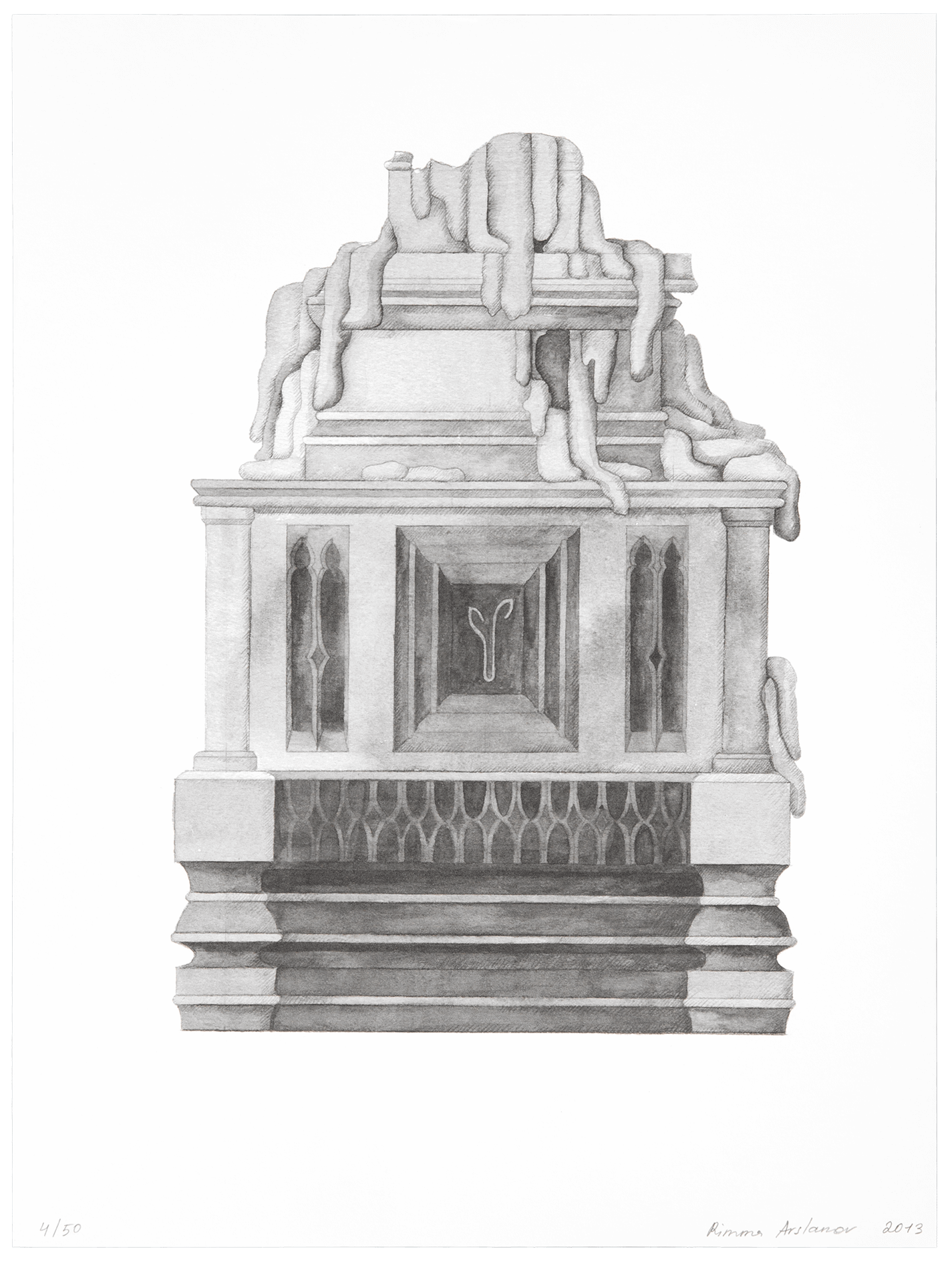
2023, 30 × 40 cm, edition: 50
pergraphica rough warm white, 300 g/m
TARO MASUSHIO
 INTERNATIONALES ATELIERSTIPENDIUM MÖNCHENGLADBACH
INTERNATIONALES ATELIERSTIPENDIUM MÖNCHENGLADBACH

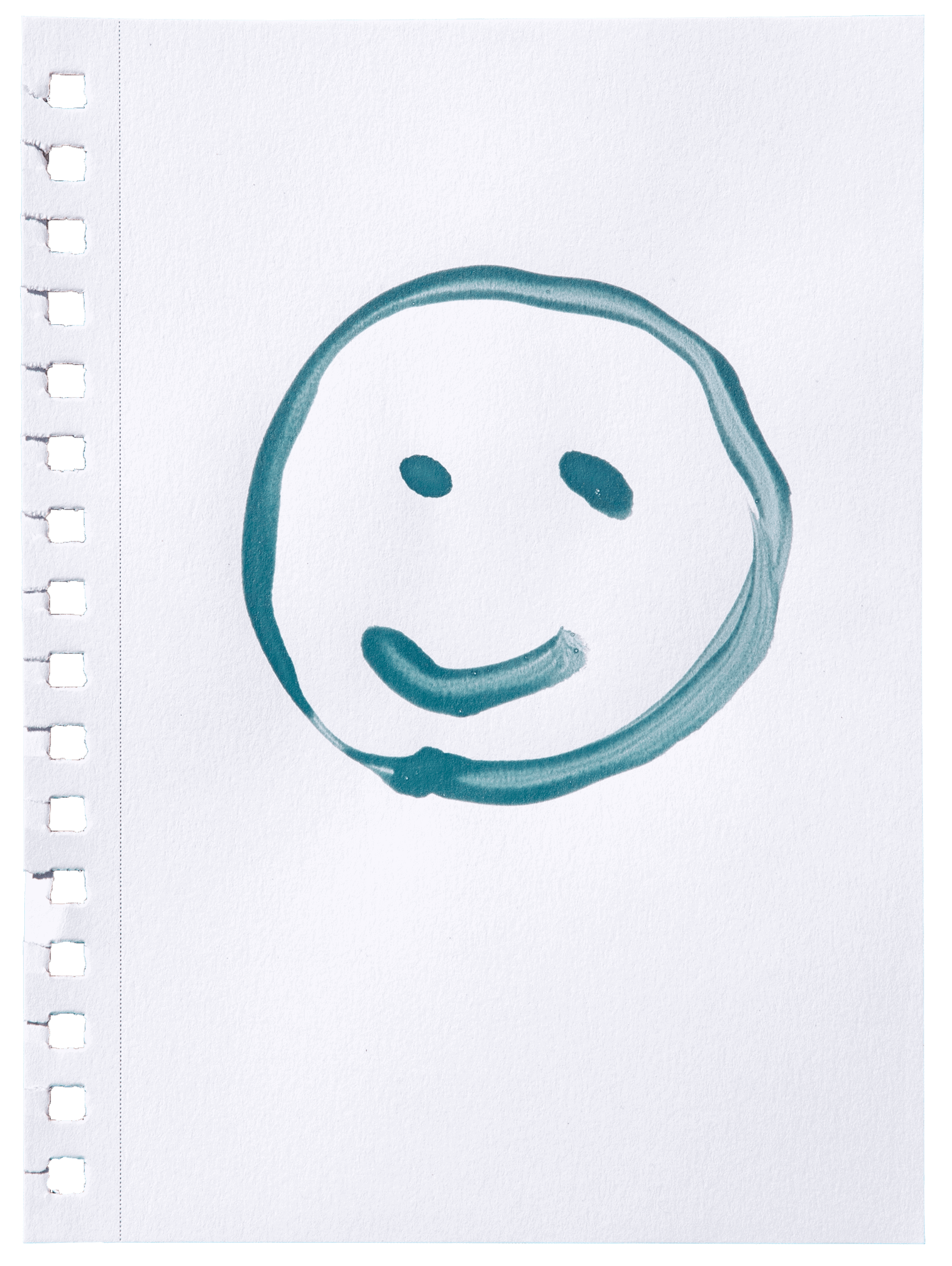
KITTY MARIA VAN EKEREN
 MUSEUM VAN BOMMEL VAN DAM, VENLO
MUSEUM VAN BOMMEL VAN DAM, VENLO

[...] the giant is a familiar figure. Almost every culture possesses some version of this monster, probably because the giant amounts to nothing more than a body enlarged to the point at which the human figure becomes estranged. Looming over our diminished selves, the giant makes evident our frailty, our mortality. Giants typically elicit terror, as in Francisco Goya’s famous painting il colosso (c. 1808), in which a panicked mob flees the monster’s towering form. Some, however, offer an invitation to corporeal pleasure: food, sex, mirth. The giant is therefore an ambivalent monster, combining fear of self-annihilation with an undercurrent of desire, forces of domination with possibilities of subversive celebration. Because only size needs distinguish giants from humans, the line separating these groups is easily traversed. Even when giants are imagined as a separate monstrous race, humans sometimes intermingle with them.”
The Ashgate Encyclopedia of Literary and Cinematic Monsters – Jeffrey Andrew Weinstock
In the video Saw Mill Gdansk_ 22-10-2021 we see three different interventions playing out during a normal working day in a sawmill in Gdansk, Poland. Each intervention represents a different method to create a sort of ontological opening into this place of performance; a hole in the relational web between people, objects and nature.
During a strange tactile tour with the manager and a scene with two female giants, the predetermined daily reality of work is interrupted by a new system of logic. Here, rules of fiction and the rules of sensory exploration are suddenly introduced in the mill. The video is part of the broader body of work in which I perform in economic contexts, performances during which various definitions of the term performance collide with one another; performance as an artistic tradition using the body as a medium competes with industrial notions of performance, the achievements and potencies of objects and machines. In the room bodies are performing all these notions, with movements of labour and movements of artistic value happening side by side.
As a third intervention I’ve used images of the mill to edit CGI elements into the space, objects or special effects that were originally not there. The mill becomes a cosy ambient space with nature sounds, crackling wood and small trees growing on the window sills. Adding another layer of fiction in a video that shifts between documentary, fiction and amateurfilm, looking for ways to withdraw from labour system.
Kitty Maria van Ekeren
(EXCERPT FROM SAW_MILL_GDANSK_2021)«
2023, 25 × 15 × 1 cm, edition: 50
hand bended aluminium print
KENNETH MORENO KIERNAN
 GREYLIGHT PROJECTS, HEERLEN
GREYLIGHT PROJECTS, HEERLEN

Kenneth Moreno Kiernan's works are characterised by a precise observation and attentiveness to detail. They reveal an empathetic subtlety and appreciation for materials, fabrics, haptics, and sensory impressions. His innate curiosity for natural elements characterises the works of the object maker and material researcher: wind, water, smoke, light; alongside other working materials such as: hardwood, aluminium, fabric, and electrical apparatuses are the focus of his research. Coming of age between Panama, Brazil and Argentina, his work, particularly his artistic research and writing, explores feelings of nostalgia and idealization for rural settings in Latin America. He plans to further expand this research as it relates to issues of migration, colonialism and their material traces in contemporary Latin America.
During his residency at Greylight Projects, Kenneth worked on a series of ceramic basins to contain and transport water as part of a material response to the historical, mythical, and religious associations with “fountain of life, fountain of youth”. The video work “carrying water on my shoulder” gives insight into his artistic practice. It shows Kenneth utilizing these basins to carry and exchange stream water between the Caumerbeek to the Overkluisde Caumerbeek, the two main streams in the Heerlen central area.
“i slept nights in hammocks in the central american rainforest, listening to the jungle sing; on lambskins on the andean mountains; in cane huts at side of the sea: gushing and flushing through the creaks, wanting to join my sisters and i in bed, but the floor was sand, and the bed was too.” (moreno kiernan, kenneth. deus ex-machina in tierra del fuego, escape-sim and the monte, 2021.)
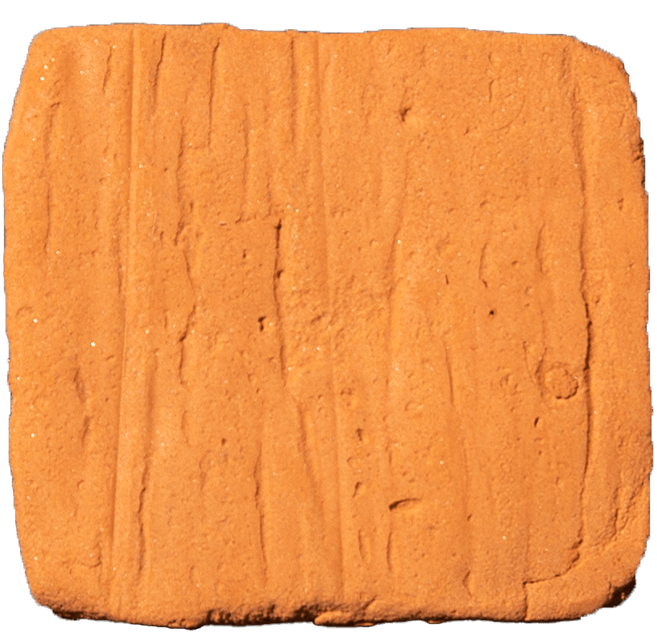
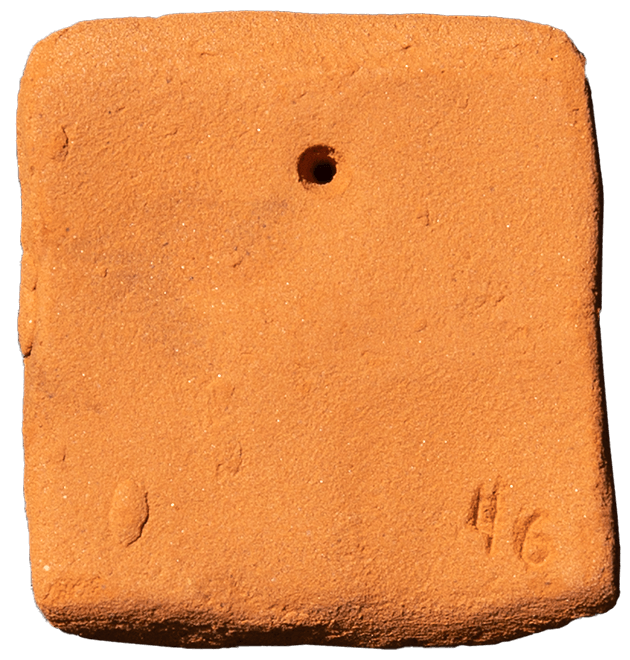
CAUMERBEEK RIVER CLAY«
2023, 4 × 4 × 0,8 cm, edition: 50
fired river clay
ELS HUVER
 ODAPARK, CENTER FOR CONTEMPORARY ART, VENRAY
ODAPARK, CENTER FOR CONTEMPORARY ART, VENRAY

It is quiet in my home as I start writing this text. You hear almost nothing, only the fridge hums a little. My chair creaks when I sit down, it is a wooden chair. I look around me. The table is also wooden, as is the cupboard to my left, the floor, and the beams in the ceiling. Oh yes, also the window frames, the top of the fireplace and the children's building blocks still strewn across the floor. The skirting boards, not to forget, and the cutting board on the kitchen counter that I still have to wash off in a moment. Oak, birch, beech, pine, teak, spruce, even bamboo, all standing together and mixed together. I see grains, knots, knars and annual rings and scarred growth lines. My living room is a forest, in which a variety of species grows, native and non-native. I live in a tree, in which every time I sit down I could hear the inside of the tree creak. I could count the holes where generations of longhorn beetles have done their best. I could calculate how long my chair took to grow from seed to chair.
I could, but I don’t. Because honestly, I am surrounded by wooden objects and furniture and yet I rarely think about the wood or where it came from. Let alone that I think about the trees these objects once were, or that I try to imagine how my window frames once rustled in the wind, how the beams in my ceiling caught the first rays of the day's sun on a hill top, or how a bird made its nest on the branches that now form the legs of my chair. Wood, I think all of a sudden, is not made by trees, it's something we humans produce. Not by sawing or chopping, but mainly by conveniently forgetting that we are actually dealing with a living organism. The moment we call it wood, we can forget about tree and forest. We know it’s there, but prefer not to think about it, so we then never think about it again, until we suddenly remember it again. Remembering something you have forgotten is one thing. That someone else has to help you remember that you forgot, idem. But admitting that you have forgotten something when you secretly know that you put it away on purpose or were simply too busy to deal with things that really matter….well...
Els Huver's project GEWORTELD worked like retrieving those tucked-away memories. Through the stories she collected, the forest and the trees and an environment I thought I knew suddenly became fresh and strange again, as if I saw them for the first time. For GEWORTELD, Els Huver interviewed a wide variety of people in Venray, of all ages. She brought their stories together in a route through the forest area adjacent to Odapark. Parallel to these stories, you were taken into the life path of the tree: how do trees form and grow, how do trees work together in an ecosystem, and if a tree dies, what happens then? While walking and listening, both storylines blended into one narrative, the apparent contradiction of 'man and nature' became the story of the development of 'life' in the broad sense of the word. The rushing voices of teenagers coincide with the stridently advancing young greenery in the forest edge, an old gnarled trunk seems to sympathise with the lady speaking from the hospice. Els Huver titled the multiple for Borderland Residencies DEMARCATIONS, thus hinting at the boundary between man and nature. She used two different photo series for this, one showing people from Venray listening to a tree, and a series with dolls found in the trees in the woods around Venray, placed there by a stranger. That she then marks the boundary between man and tree in these photos with needle and thread seems a fitting poetic translation of the audio work GEWORTELD. As in the audio, Els indicates the border, thus naming the differences between man and nature and at the same time pointing out how much both have in common. Els weaves on that border with her work, both in audio and photography. She weaves man and nature together to show: we are all part of the same piece of fabric.
JOEP VOSSEBELD
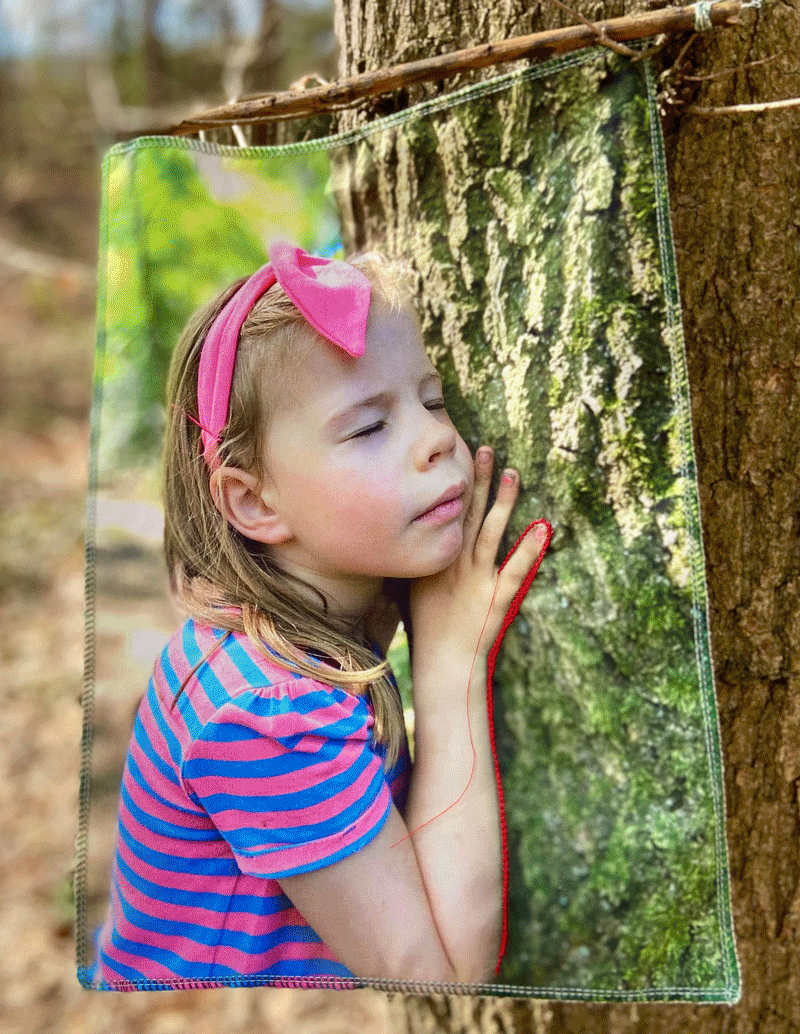
2023, 30 × 40 cm, edition: 50
photo on hennep, stitching and embroidering
JAN-LUKA SCHMITZ
 KUNSTGENERATORSTIPENDIUM VIERSEN
KUNSTGENERATORSTIPENDIUM VIERSEN

studium and punctum in the oeuvre of Jan-Luka Schmitz
Large-format, skillfully crafted acrylic paintings, in which human subjects are found without exception, characterize the works of Jan-Luka Schmitz. As can also be seen in his mixed media print „Pillowphony (1:10)“, he pairs strong contrasts with strict compositions. In doing so, they dominate not only the pictorial space, but also the pictorial personnel: the bodies deform, for they are figurated through the composition.
The trinity of contrast, composition and human image personnel helps to quickly find one's way into the pictorial worlds. The clear lines provide orientation; the intense contrasts give weight to individual pictorial contents and their urgency; the people shown direct the viewing regime of the pictorial spaces and enable a literal immersion in what is shown. Directly, almost involuntarily, a kind of feedback loop is ignited between recipients, aesthetic experience and work, in which a somewhat symmetrical, harmonious relationship is initially cultivated. In 1989, the French post-structuralist Roland Barthes found a fitting vocabulary for spelling out this harmonious relationship in the principle of studium:
"What I feel about these photographs derives from an average affect, almost from a certain training. I did not know a French word which might account for this kind of human interest, but I believe this word exists in Latin: it is studium, which doesn’t mean, at least not immediately, "study", but application to a thing, taste for someone, a kind of general, enthusiastic commitment, of course, but without special acuity. [...] for it is culturally (this connotation is present studium) that I participate in the figures, the faces, the gestures, the settings, the actions." (p. 26)
At first, when one is mildly involved in the average affect of the image, everything remains orderly and comprehensible – the world of the image has apparently revealed itself.
But as soon as an attempt is made to reflect this initial, harmonious experience back on the picture, something remarkable happens. A barely noticeable tremor takes hold and cracks open up. Something becomes uncomfortable. It disturbs and bumps against this supposed harmony cultivated in the studium. Irritated, loose questions form: 'Why are these bodies so deformed?' or 'Why do these cushions fly through the air in a slightly too choreographed way?'
These are forms and scenes carefully arranged along the composition, sometimes humorous, but always grotesque, thwarting the symmetrical experience of the studium. The average affect is thwarted by bursts of precise staging.
Again, it is Barthes who provides us with appropriate words: "This second element which will disturb the studium, I shall therefore call punctum; for punctum, is also: string, speck, cut, little hole [...] is that [...] which pricks me (but also bruises me, is poignant to me)." (ibid. p. 27) And indeed, this wounding, this puncturing of the once smooth relationship to the work leads to an opening in which the affective emerges as that quality in which answers are no longer found and assurances are no longer made. Through the punctum, one's own experience becomes more intense and intimate, but also more dangerous. The reception of Schmitz's works opens up a double experience that oscillates between harmony and disruption. The individual and own aesthetic experience comes to the fore. For it is this that is revealed in the punctum.
Jan-Lukas Schmitz is a painter of the grotesque and is not afraid to think bodies through compositions. He constellates scenes in which the studium runs into the void. Punctuated and challenged by an affective address, the recipients remain questioning, astonished or even confused.
Joshua Ben Pesch-Ulonska
Source:
Barthes, Roland. Camera Lucida: Reflections on Photography. Translated by Richard Howard. Farrar, Straus & Giroux Inc: 1999.
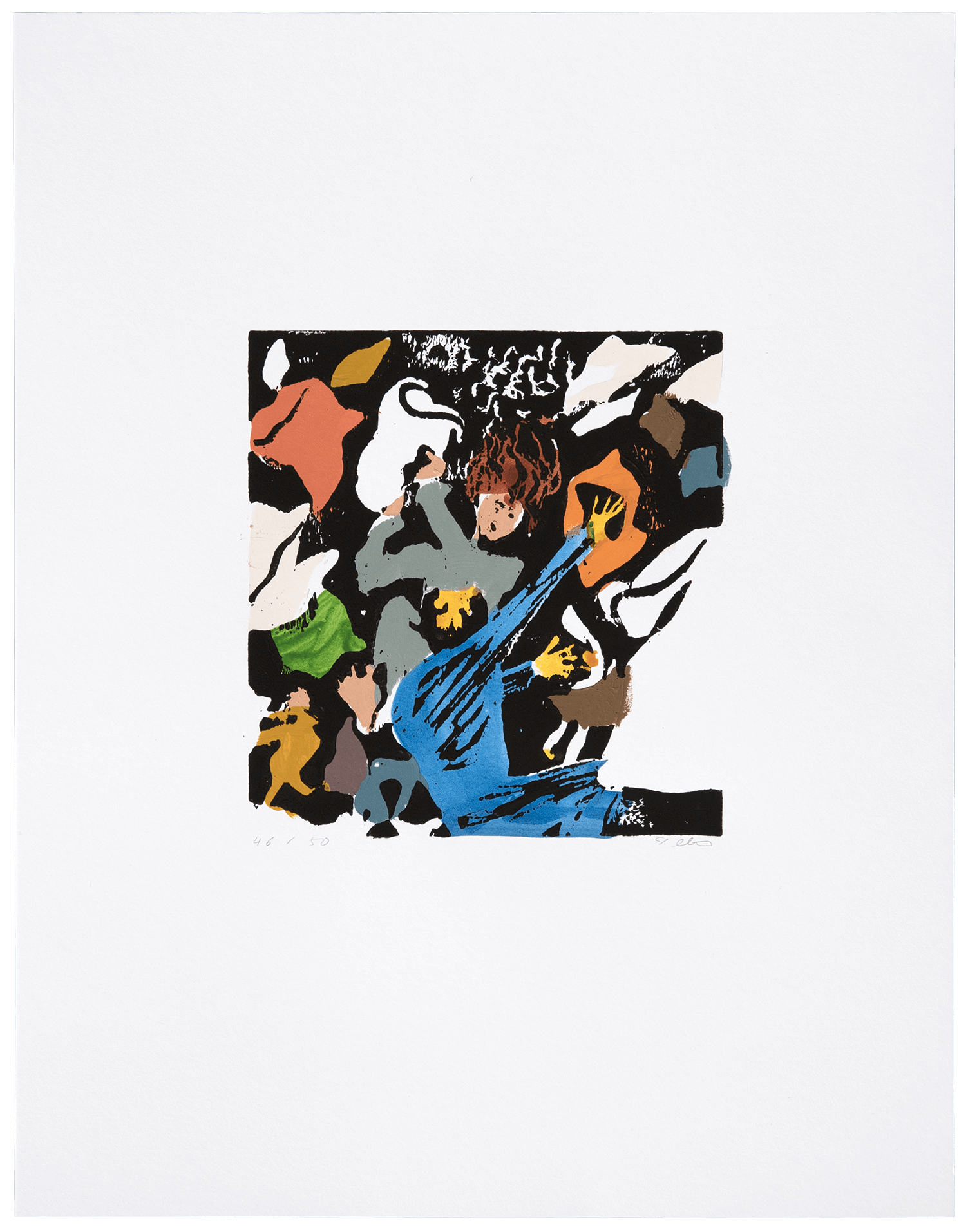
2023, 38 × 29,8 cm, edition: 50 + 3 AP
mixed media on paper (acrylic / watercolour / linocut)
ELISA VERKOELEN
 HAUSMUSEUM, OTZENRATH, JÜLICH-HOCHNEUKIRCH
HAUSMUSEUM, OTZENRATH, JÜLICH-HOCHNEUKIRCH

what could not be touched
Making a linocut is turning the world upside down. You have to think the other way round, because unlike a drawing made with pencil or pen where you add ink or graphite to the paper, the black areas on the print are the ones you should not touch while making the printing plate. By cutting away the areas and lines that should remain white in the final print, you focus on emptiness. It is the poetry of the linocut; you need emptiness to make visible what you have not touched.
The prints Elisa Verkoelen made as a result of her stay at Hausmuseum go one step further. Her experiences, meetings and walks in the region around the Garzweiler lignite mine made her decide not to add anything to the final art work. The relief of the linocut echoed the quarries in the mining landscape, the cutting into the subsoil seemed synonymous with the machine scrapers and diggers that wiped entire villages off the face of the earth. She printed the linocuts without ink in specially prepared paper, leaving only the relief of the drawing in the paper. It led to works that look like a blank sheet of paper from a distance, and only reveal their secret from closer inspection. It is like a memory resurfacing, a lost village emerging from the mist, scars that slowly heal but always remain visible.
By creating a work where Elisa did not add any materials, but only stretched fibers of the paper, she made a homage to Inge Broska's Hausmuseum. The Hausmuseum essentially revolves around the same principle. It adds nothing, but only shows what was left behind: the objects that residents left behind when they were forced to leave their village because of the mining. Perhaps the Hausmuseum itself is like the printing plate of a linocut. In a landscape that was cut away and the void it left behind, the Hausmuseum shows what was not touched by the mine because it could not be touched: the memories, the stories and the power of imagination.
JOEP VOSSEBELD

2023, 30 × 40 cm, edition: 88
Blind embossing on 300g Hahnemuhle paper. »Geboortegrond / Mutterboden«
is a series that consists of two blind embossed prints, counting 44 copies each.
FRAUKE BERG AND OLIVER GATHER
 HAUSMUSEUM; OTZENRATH, JÜCHEN_HOCHNEUKIRCH
HAUSMUSEUM; OTZENRATH, JÜCHEN_HOCHNEUKIRCH

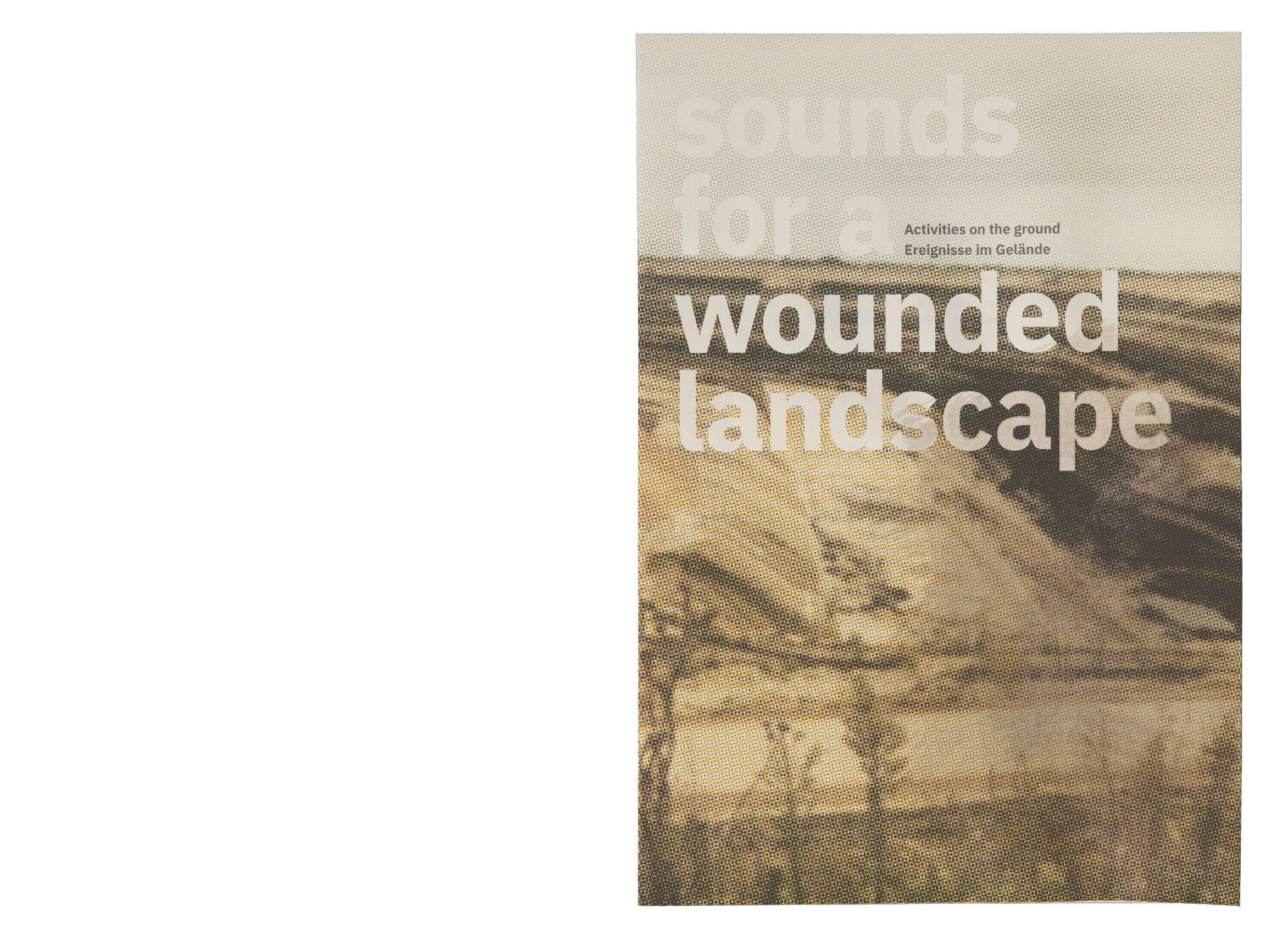
2023, 21 × 29,7 cm, edition: 70
drawing ink as digital print / 16 pages 4c / with link to movie clip
LUCIANA ARDITTO
 A271 ATELIERS HÖHERWEG, DÜSSELDORF
A271 ATELIERS HÖHERWEG, DÜSSELDORF

Imaginary archaeological sites
From the very beginning, my work always focusses on the possible transformations that matter can undergo as a result of its interaction with the world. Certain invisible phenomena, such as physical laws or the passage of time, are revealed by changes in the properties of the objects, such as corrosion or damage. I use this process as an inspiration for my artistic work. But instead of showing the passage of time through the material, I show it through the traces I imagine it would leave on a surface, in this case, the paper. Gravity keeps all objects pressed to the planet, and over time that always leaves an impression. These marks - a hole in the ground, an incision in the territory - are revealed when the object disappears. That's why I think about this series as a kind of archaeology because, as happens in this practice, from a small trace, an imaginary world is remade.
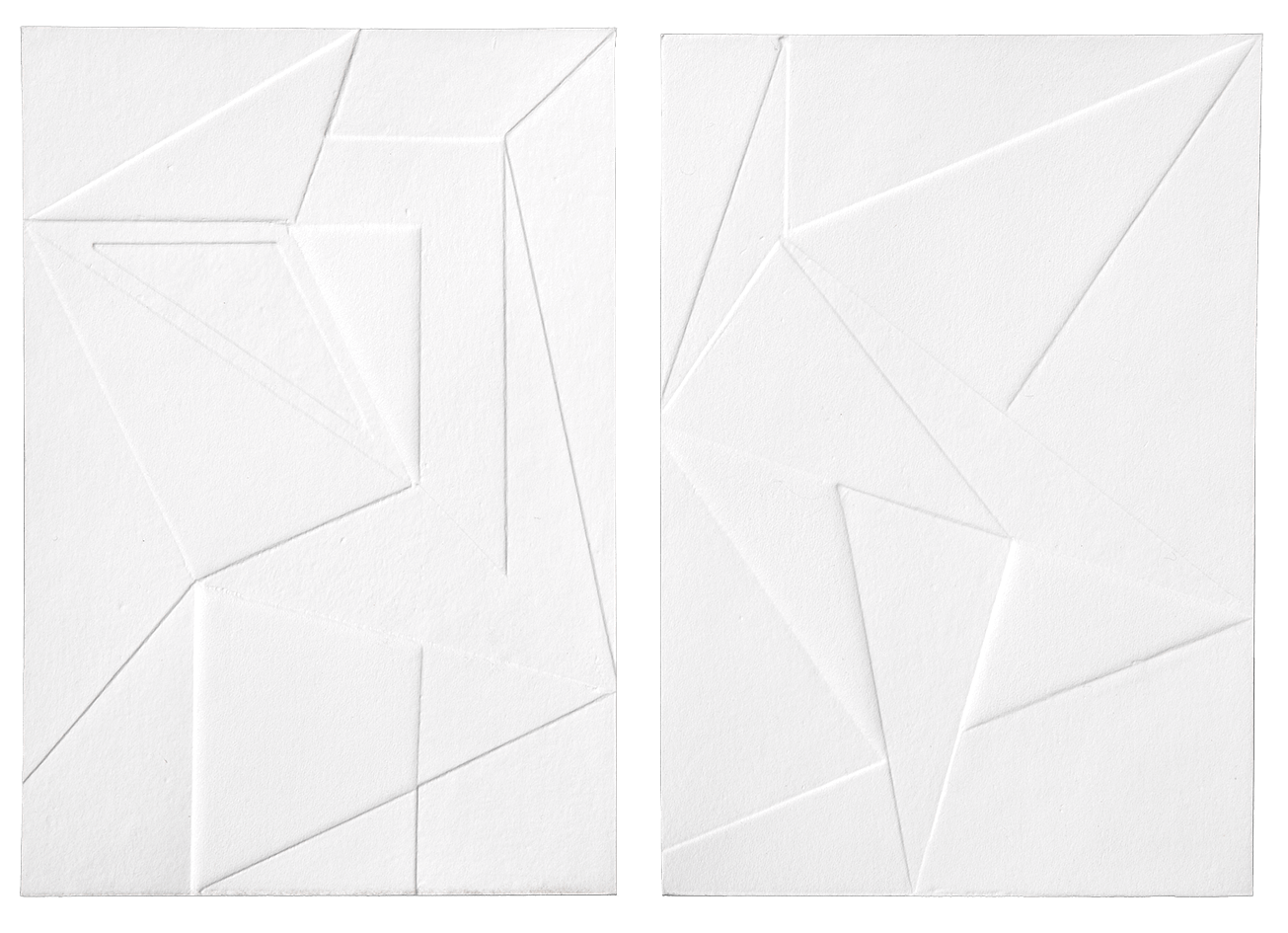
2023, 20 × 14 cm, edition: 50
embossing on paper
ALICIA KREMSER
 MUSEUM KATHARINENHOF UND VAN DER GRINTEN-HOF, KRANENBURG
MUSEUM KATHARINENHOF UND VAN DER GRINTEN-HOF, KRANENBURG

Alicia‘s work is characterised by a special, deep interest in the relationship and interaction with the viewers of her works. Fascinated by the uniqueness of a space, she traces the specific moment of a place and a point in time: "I reflect on concepts such as vulnerability and desires, externalizing my own longing for connection and simultaneously seeking and trying to facilitate refuge. Drawing people in with an invitation for mutual intimacy, I believe we can confide in inter-reliance."
Alicia Kremser creates spaces, actual spaces, but more often imaginary spaces, in which viewers must orient themselves and are invited to develop their own associations and reflections. She works with everyday objects – a ladder, a bed, a swing – but almost always with light: the natural light of the sun and the movements it causes on a surface of water, for example. In many cases, however, she also uses the artificial, often glaring light of spotlights and self-made devices to create shadows and project text fragments onto walls or other surfaces – also and especially in public spaces.
Right at the beginning of her residency, the artist created the installation "I'd rather sleep alone but am afraid of the dark" in the interior of a former transformer station, which is only a few square metres in size, using found objects from the van der Grinten house and a powerful projector, among other things. The choice of materials and the narrowness of the room, which cannot be entered directly but can only be seen from the outside through a window, create a special intimacy for the viewer. Here, as in the actual project space on Nimweger Straße, visitors can thus view new and newly presented works at any time and in the context of the respective time of day, again and again in a new and different way.
In the last phase of her time in Kranenburg, Alicia Kremser developed the concept for an initially temporary work for a part of the historic centre of Kranenburg that many describe as particularly idyllic: "Do you ever" is to be created as a sculpture reflecting its surroundings in the middle of the water surface of an old duck pond in the immediate vicinity of the old town wall.
The Museum Katharinenhof in Kranenburg, together with the Kranenburg Project Space, hosted artist Alicia Kremser for three months during her Borderland Residency. The project space, which was not established until 2022, is located in the former house of the brothers Hans and Franz Joseph van der Grinten, who built up their extensive art collection there from 1946. This special place, a farm where Joseph Beuys lived for a few months in 1957 as a guest of his friends and which was also the site of the famous stable exhibitions, has only recently been available again for exhibitions and projects.
Peter Schünemann
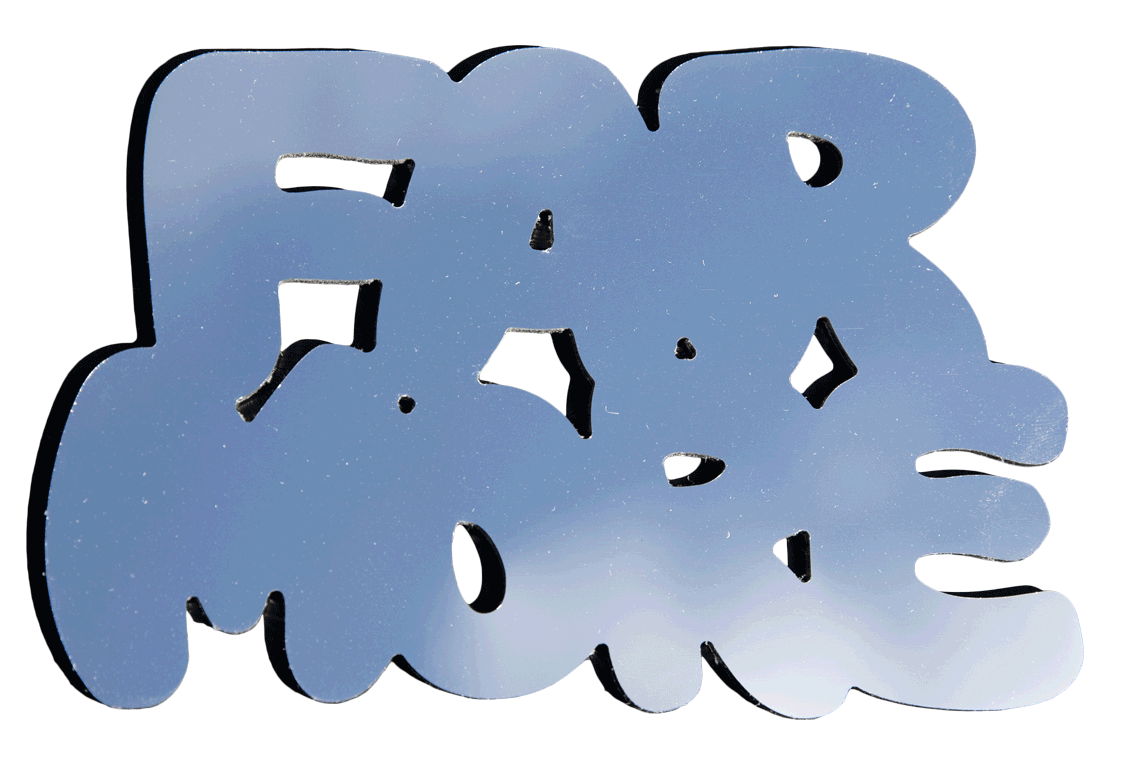
2023, 10 × 15 cm, edition: 60
dibond mirror, milled
AMAUTA GARCÍA AND DAVID CAMARGO
 KUNSTMUSEUM BOCHUM
KUNSTMUSEUM BOCHUM

Amauta García & David Camargo's artistic and research work finely weaves relationships of kinship, visiting histories, linking places and proposing practices of care, not only between people, but – and above all – with the earth and its temporality. Their works have investigated the impact of real estate bubbles and the effort to find tenderness in a sometimes violent world. It is a work that also weaves filiation with different social movements, actions of resistance, a creative resistance, creating ways of inhabiting and coexisting with others and with the world.
With elements of architecture, sculpture, video and virtual environments, García & Camargo tell stories that are at once personal, social and political. They ask: How can we relate to the land beyond its exploitation? How do the people, who have made the land and defended it, relate to the volcanoes that create or destroy our worlds? García & Camargo engage in a conversation between the volcanic soil of their homeland in Mexico, the Dutch underwater volcano Zuidwal, and other histories buried in the subsoils that bear the wounds of years of violent extraction, as in the case of the subsoils exploited by mining in Bochum, Germany.
The aesthetics, understood as the fabric of social relations, the scale and dimensions of our perception and a shared sensitive experience, that García & Camargo's work evokes can be understood as an active search for the heritages and lineages that link them to the ground we walk on, to the dimension of geological time, to their ancestors and their stories, languages and songs. Digging into the earth, digging into traditions, digging into their own family histories to connect, to create kinship, to tell stories that make futures possible. Together they have delved into the story of García's mother, who in 1971 participated in Latin America's largest illegal land invasion in the volcanic enclave south of Mexico City. This exercise in active inheritance re-signifies the creative resistance of García's mother. It recognises her as Xocoyota, as akin to the creators and destroyers of the earth, a sister to the volcanoes. And this kinship is not limited to the volcanic zone south of Mexico City, it is a sisterhood that links her to the underwater volcano Zuidwal, to the Bochum coalfields through the veins of lava, gas and minerals of the earth.
García & Camargo's powerful work also manages to center a way of looking at the world, and our relationship with it with a language that is not that of colonial extractivism, but that of a filial relationship: a re-indigenisation of the world. It is an inspiring projection that moves away from the modernizing paradigm, from Western development, and which I personally like to feel as a decolonial intervention. As an invitation to listen, to contemplation and to recognise ourselves in our filiations, as part of a whole that pulses in everyone and that we must re-learn to care for.
Alexis Rodríguez
Mi madre siamesa del Paricutín
es volcán monstruosa,
es limítrofe entre mundos despojados.
es canto de grillos que sostienen el cielo
es temblor que desmorona cerros
es catarina que me enseño oler las flores
es voz de oceáno de voces,
es pies quer fundan cuidades
es manos que construyen casas
es anhelos que llegaron de todas partes
a romper piedras
y hacer jardines multicolores de rocas volcánicas.
Volcán monstruosa
imaginó lo que tenía derecho a imaginar
arranco lo que no debía arrancar
existió donde no estaba llamada a existir
My conjoined mother Paricutín
is a monstrous volcano,
border between stripped worlds.
she is the song of crickets that hold up the sky
she is the earthquake that crumbles mountains
she is the ladybug who showed me how to smell the flowers
she is voice of an ocean of voices
feet that found cities
hands that build houses
yearnings that came from all over
to break stones
and make multicolored gardens of volcanic rock.
Monstrous volcano
she imagined what she had no right to imagine
uprooted what she should not uproot
existed where she was not called to exist.
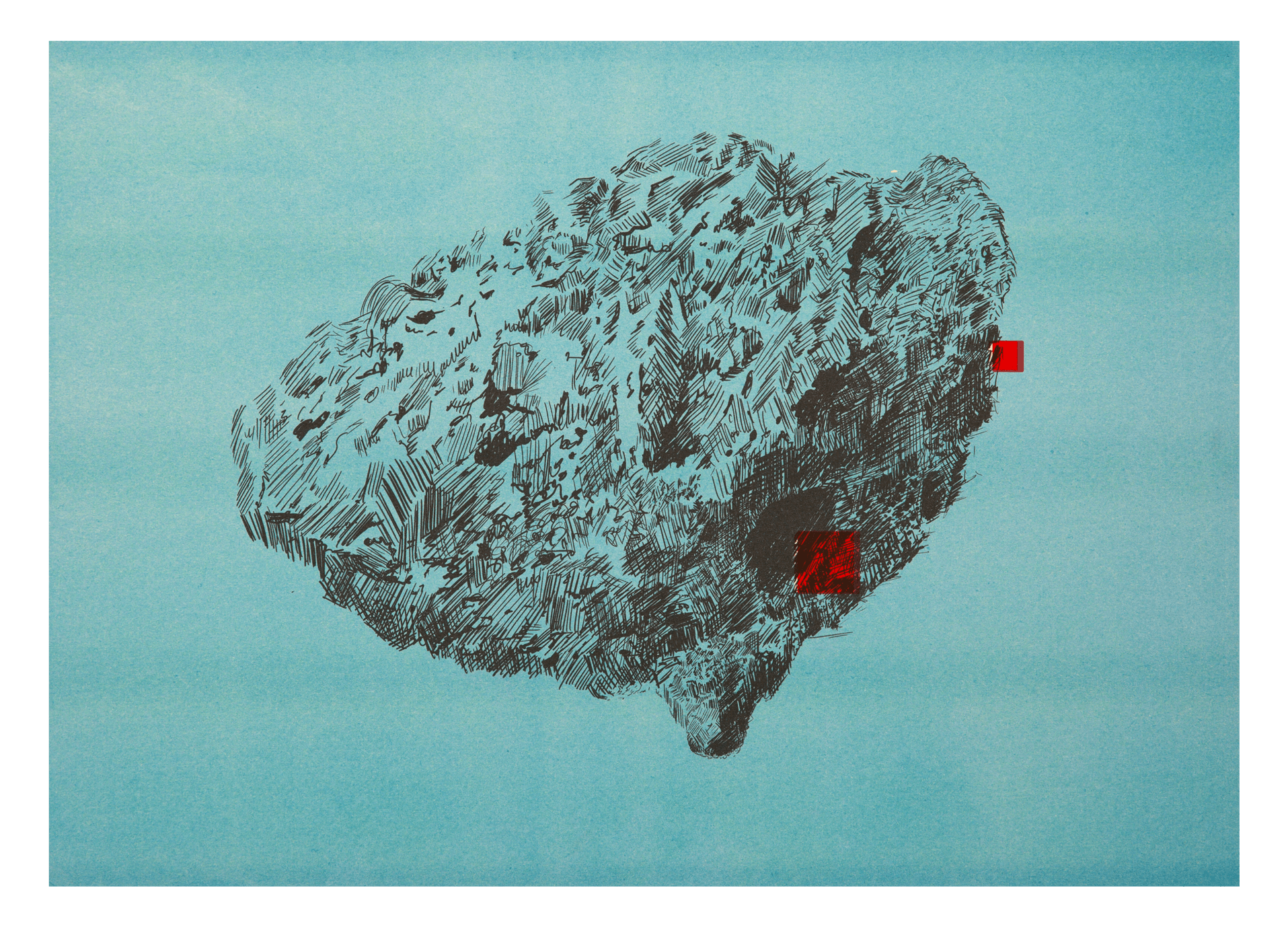
2023, 30 × 40 cm, edition: 50
risograph printing on paper
